- home
- BAKERECIPES
BakeRecipes
Bringing real baking into your home with deliciously simple recipes.
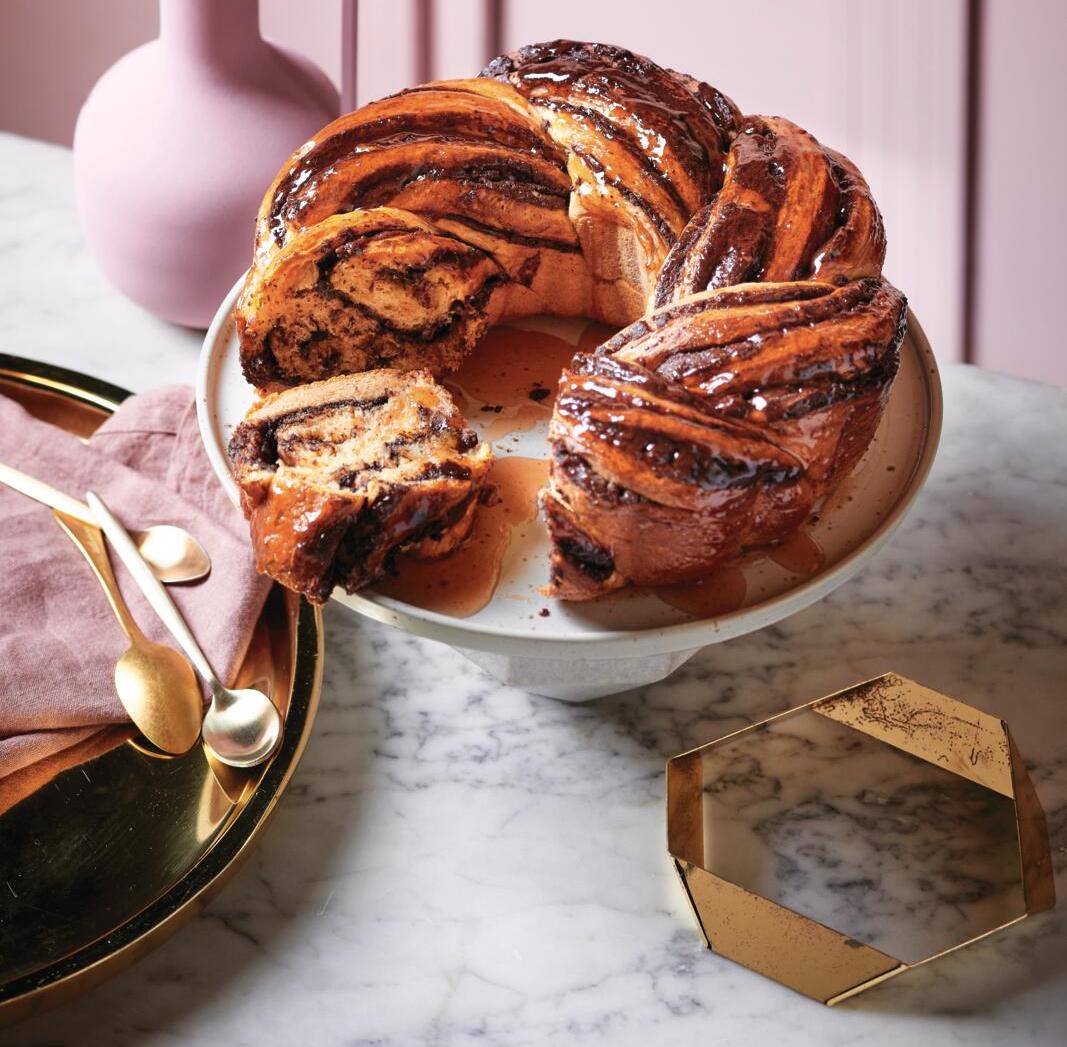
Prep 40min (+ 3hr proving, 20min standing and cooling time)Bake 45min12-14 serves
Laced with swirls of rich dark chocolate and drenched in a marmalade glaze, you’ll find this impressive loaf hard to resist – I dare you to stop at just one slice!
Ingredients
525g (3½ cups) strong (baker’s) flour
2 teaspoons instant dried yeast
75g (⅓ cup) caster sugar
½ teaspoon fine salt
Finely grated zest of 1 orange
180ml (⅔ cup) lukewarm milk
2 eggs, plus 1 extra
150g unsalted butter, softened, plus extra to grease
Chocolate Filling
150g dark (70%) chocolate, chopped
50g unsalted butter, chopped
110g (½ cup, firmly packed) brown sugar
Marmalade Glaze
300g jar blood orange marmalade (see Baker's Tips)
2 tablespoons boiling water
Method
- To make the dough, combine the flour, yeast, sugar, salt and orange zest in the bowl of a stand mixer fitted with the dough hook. Combine the milk and eggs in a jug. With the motor running, add milk mixture to the flour mixture and knead on low speed for 1-2 minutes or until mixture is evenly combined and a stiff dough forms.
- Switch to the paddle attachment and gradually add the butter, about 20g at a time, beating well after each addition on low speed until dough is smooth and very elastic (this will take about 5 minutes). Scrape down side of bowl, cover with plastic wrap and set aside in a warm, draught-free place for 1 hour 30 minutes or until dough has doubled in volume.
- For the Chocolate Filling, combine all ingredients in a large heatproof jug and microwave on high, in 30 second bursts, stirring after each burst, for 1 minute 30 seconds or until chocolate has melted. Stir vigorously until well combined, glossy and smooth. Set aside at room temperature to cool.
- Grease a 2.5L capacity (24cm top, 22cm base measurement) fluted ring pan with extra butter. Knock back the dough by punching it in the centre with your fist. Turn onto a lightly floured surface and knead for 1-2 minutes until smooth and elastic and dough has returned to its original size.
- Use a lightly floured rolling pin to roll dough into a 30cm x 35cm rectangle. Spread dough evenly with the chocolate filling. Starting from the longer end, roll up the dough into a tight roll. (At this point, if the dough is too soft and your kitchen too warm, you can place the log, slightly bent to fit, on a large baking tray lined with baking paper and chill for 20 minutes to firm slightly. This will make cutting and shaping the babka easier). Trim ends of roll. Starting about 2cm from the top end, cut in half, leaving the top end intact. Turn each half so that the cut edges are facing upwards. Twist the two halves together, keeping the cut edges facing upwards. Place in prepared tin, wrapping around the centre tube. Cover with plastic wrap and set aside in a warm, draught-free place for 1½ hours or until well risen.
- Preheat oven to 180°C (160°C fan-forced). Bake the babka for 45 minutes or until deep golden and babka sounds hollow when tapped on the top. Stand in the pan for 10 minutes before turning out onto a wire rack to cool.
- For the marmalade glaze, place marmalade in a large heatproof jug and microwave on high for 30 seconds. Stir well, then microwave for a further 15 seconds or until bubbling. Immediately stir through boiling water until well combined. Stand for 3 minutes, stir again, then drizzle over the cooled babka. Set aside for 10 minutes to cool slightly.
- Cut babka into wedges to serve.
Baker's Tips
- This loaf is best eaten the day it is made but it will keep in an airtight container at room temperature for up to 3 days and is perfect to slice, toast and served warm (especially for an indulgent breakfast!)
Photography: Nigel Lough
Styling: David Morgan
This recipe first appeared in delicious. Australia's April 2023 edition.
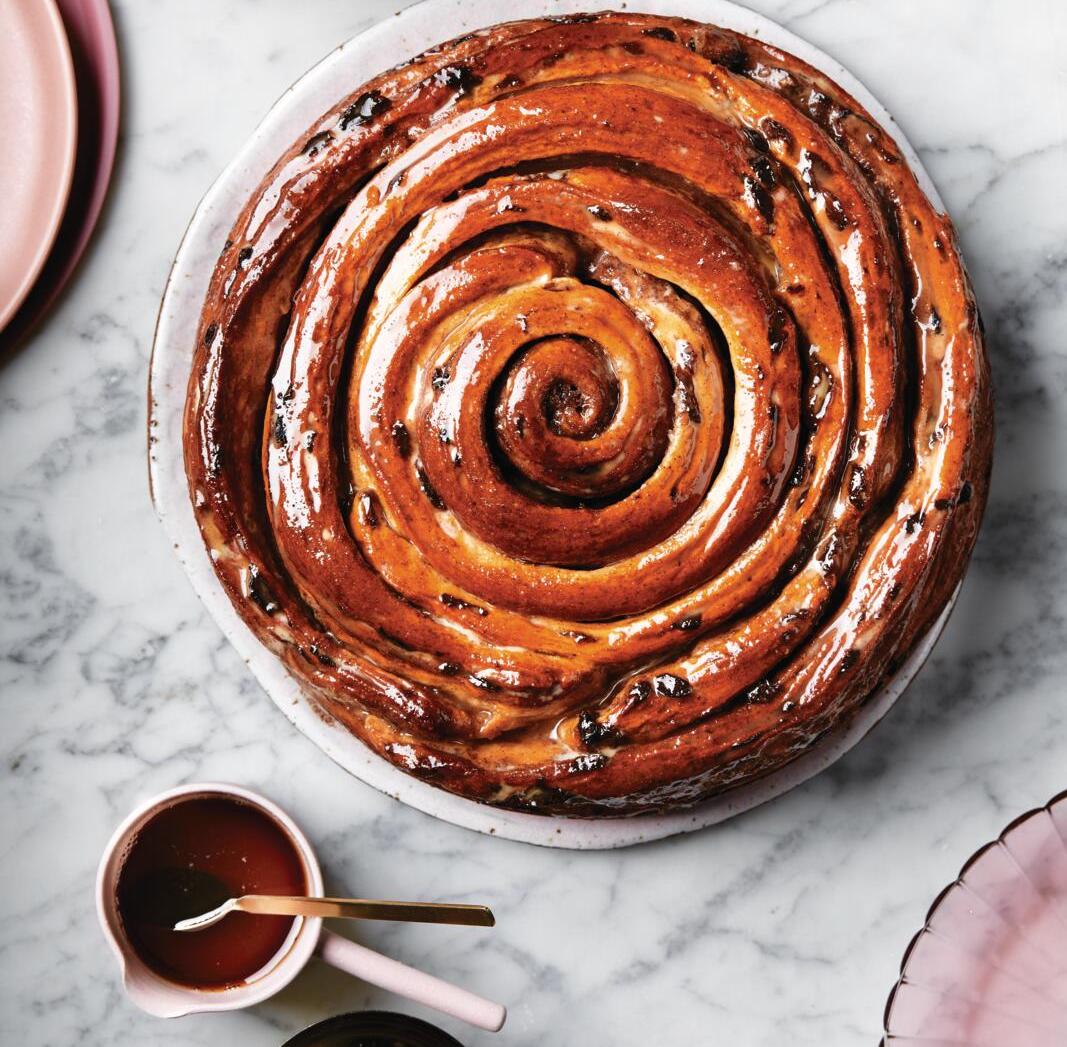
Prep 40min(+30min standing and 1hr 45 min proving time)Bake 1hr-1hr10minMakes 12-15 serves
Hot cross bun meets cinnamon scroll! With all the flavours of Easter plus cinnamon richness, this brings together two all-time favourites… Once you’ve tried it, it will be hard to go back to one without the other.
Ingredients
¼ cup (60ml/2fl oz) maple syrup
3 teaspoons pure icing sugar, sifted
Salted butter, to serve
Dough
60g (⅓ cup/2oz) seedless raisins
60g (⅓ cup/2oz) sultanas
55g (⅓ cup/2oz) currants
560g (3¾ cups/1lb 4oz) strong bread or pizza flour, plus extra for dusting
55g (¼ cup/2oz) caster sugar
1½ x 7g/¼oz sachets (3 teaspoons) instant dried yeast
2½ teaspoons mixed spice
1½ teaspoons ground cinnamon
¾ teaspoon fine salt
45g (1½oz) unsalted butter, diced and softened, plus extra to grease
1 egg, at room temperature, plus 1 extra, whisked, to glaze
1½ teaspoons natural vanilla extract or essence
310ml (1¼ cups/10½fl oz) lukewarm milk
Filling
60g (oz) unsalted butter, softened
⅓ cup (75g/2¾oz) brown sugar
3 teaspoons ground cinnamon
¼ teaspoon fine salt
Method
- Place the raisins, sultanas and currants in a heatproof bowl. Cover with boiling water and set aside to soak for 20 minutes until the fruit is plump. Drain well.
- Place the flour, sugar, yeast, mixed spice, cinnamon and salt in a large bowl and mix to combine. Add the butter. Whisk the egg and vanilla into the lukewarm milk. Add to the dry ingredients and use a wooden spoon and then your hands to mix to a soft dough.
- Turn the dough out onto a lightly floured bench top. Knead for 8-10 minutes or until smooth, elastic and springs back when you poke your finger into it (see notes).
- Lightly grease a clean large bowl with extra butter. Add the dough and well-drained fruit and use your hands to mix through (the fruit doesn’t need to me evenly distributed at this stage). Cover the bowl with plastic wrap and set aside in a warm, draught-free place for 1 hour or until doubled in volume.
- Grease a 24cm/9½in (base measurement) springform tin with extra butter. Remove the side from the base and then place a square of non-stick baking paper over the base of the pan, allowing it to overhang the edge of the base (do not reattach side of tin at this stage). Set aside.
- For the Filling, place the butter, sugar and cinnamon in a medium bowl and use a wooden spoon to beat until evenly combined and soft.
- Knock back the dough by punching it in the centre with your fist. Turn onto a lightly floured surface and knead for 1-2 minutes or until smooth and elastic, the dough has reduced to its original size and the fruit is evenly distributed. Use a lightly floured rolling pin to roll out the dough to a 30cmx40cm (12inx16in) rectangle, about 1.5cm (5/8in) thick.
- Spread the filling as evenly as possible over the dough. Use a large sharp knife or a pizza cutter to cut the dough lengthways into 6 even strips. Roll one of the strips into a scroll and place in centre of prepared tin. Wrap another strip around the centre scroll. Repeat with remaining strips to make one large scroll. Clamp side of tin around base to secure. Clamp the side of the pan around the base to secure (there will be about 2cm/¾in between the outside of the scroll and the side of the pan).
- Brush the top of the scroll with the whisked egg and cover with plastic wrap or a tea towel. Set aside in a warm, draught-free place for 45 minutes or until well risen, puffy and has increased in volume by about 50 percent.
- Meanwhile, preheat oven to 180°C/350°F (160°C/315°F).
- Bake the scroll in preheated oven for 1 hour to 1 hour 10 minutes or until deep golden and sounds hollow when tapped on the top.
- Meanwhile, place maple syrup and icing sugar in a small jug and whisk until combined and smooth. Remove the scroll from oven and immediately brush top with maple syrup mixture. Stand in tin for 10 minutes before removing. Cut scroll into wedges, and serve warm with salted butter.
Baker's Tips
- This scroll is best eaten the day it is made.
- It is really important not to add too much extra flour when kneading the dough by hand as this excess will make your dough stiff and hard to knead, and your final scroll will be heavy and dense. Make sure you only lightly dust your bench top and hands and use as little additional flour as you can while kneading. A softer dough at the end of kneading will mean lighter, more palatable scroll.
- To knead your dough using a stand mixer, place the flour, sugar, yeast, mixed spice, cinnamon, salt and butter in the mixer bowl and use the dough hook to mix to combine. With the motor on low speed, add the milk, egg and vanilla mixture and continue to knead for 5-8 minutes or until the dough is smooth and elastic.
Photography: Nigel Lough
Styling: David Morgan
This recipe first appeared in delicious. Australia's April 2023 edition.
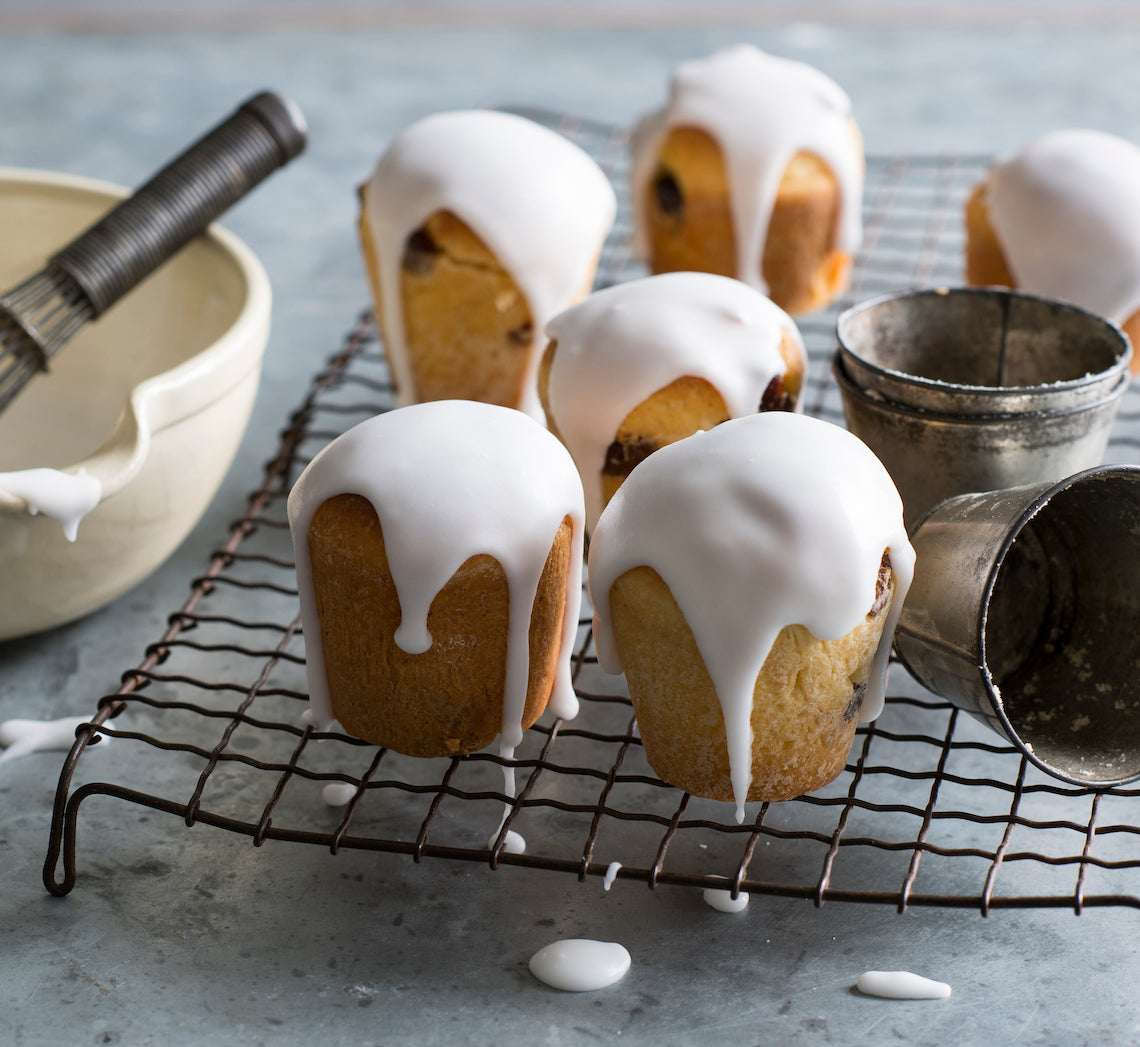
Prep 35min (+1hr 15min resting time)Bake 30minMakes 12
Many countries have their own version of this egg-rich, cake-like bread. This simple, slightly sweet, citrus-scented Ukrainian Easter one is typically baked in tall and cylindrical moulds just like Russian Kulich and Italian panettone.
Ingredients
5 egg yolks, at room temperature
1 whole egg, at room temperature
110g (½ cup) caster sugar
2 teaspoons natural vanilla essence or extract
½ teaspoon salt
185ml (¾ cup) lukewarm milk
10g (3 teaspoons) dried yeast
finely grated rind of 1 lemon
525g (3½ cups) plain flour, plus extra to dust
150g butter, cubed, at room temperature
170g (1 cup) seedless raisins
melted butter, to grease
Icing
370g (3 cups) pure icing sugar
3-4 tablespoons water
Method
- Put the egg yolks, egg, sugar, vanilla and salt in the bowl of a stand mixer and beat on high until pale and well combined. Add the milk, yeast and lemon rind and beat on low speed to combine. Gradually beat in 300g (2 cups) of the flour on low speed until combined. With the motor running gradually add the butter, a cube at a time, alternating with the remaining 225g (1½ cups) flour until a smooth, soft dough forms. Replace the beater with a dough hook and continue to knead on low speed for about 6 minutes or until very smooth and elastic. (Alternatively, turn onto a lightly floured bench and knead by hand for 10-15 minutes.) Knead in the raisins. Cover the dough in the bowl with plastic wrap and set aside in a warm draught-free place for 45 minutes or until doubled in size.
- Grease and lightly flour 12 x 125ml (½ cup) dariole moulds. Punch the centre of the dough down with your fist and turn onto a well-floured surface. Knead for 2-3 minutes or until smooth. Divide the dough into 12 equal portions, roll into balls and drop each into a prepared tin. Cover the moulds with a slightly damp tea towel and set aside in a warm draught-free place for 30 minutes or until the dough has risen to the top of the tins.
- Preheat the oven to 180°C.
- Bake the babkas in preheated oven for 28-30 minutes, covering the tops with foil if they start to brown too quickly, or until cooked when tested with a skewer and they sound hollow when tapped on the base. Stand in the moulds for 5 minutes before turning onto a wire rack to cool.
- To make the icing, put the icing sugar in a medium bowl and stir in the water to make a medium coating consistency. Spread over the tops of the babka, allowing it to drizzle down the sides. Set aside for the icing to set. Serve warm or at room temperature cut into slices.
Baker's Tips
- The babka dough can also be baked in two 9 x 19cm (base measurement) loaf tins. Grease and lightly flour as for the moulds. Divide the dough in half, roll each portion into a log about 15cm long and place in the prepared tins. Bake for 40 minutes or until cooked when tested with a skewer and they sound hollow when tapped on the base.
- This babka is best eaten the day it is made. To freeze, wrap well in plastic wrap and then seal in an airtight container or freezer bag and freeze for up to 3 months. Thaw at room temperature.
CLICK HERE for more Bakeproof recipes.
Photography by Alan Benson.
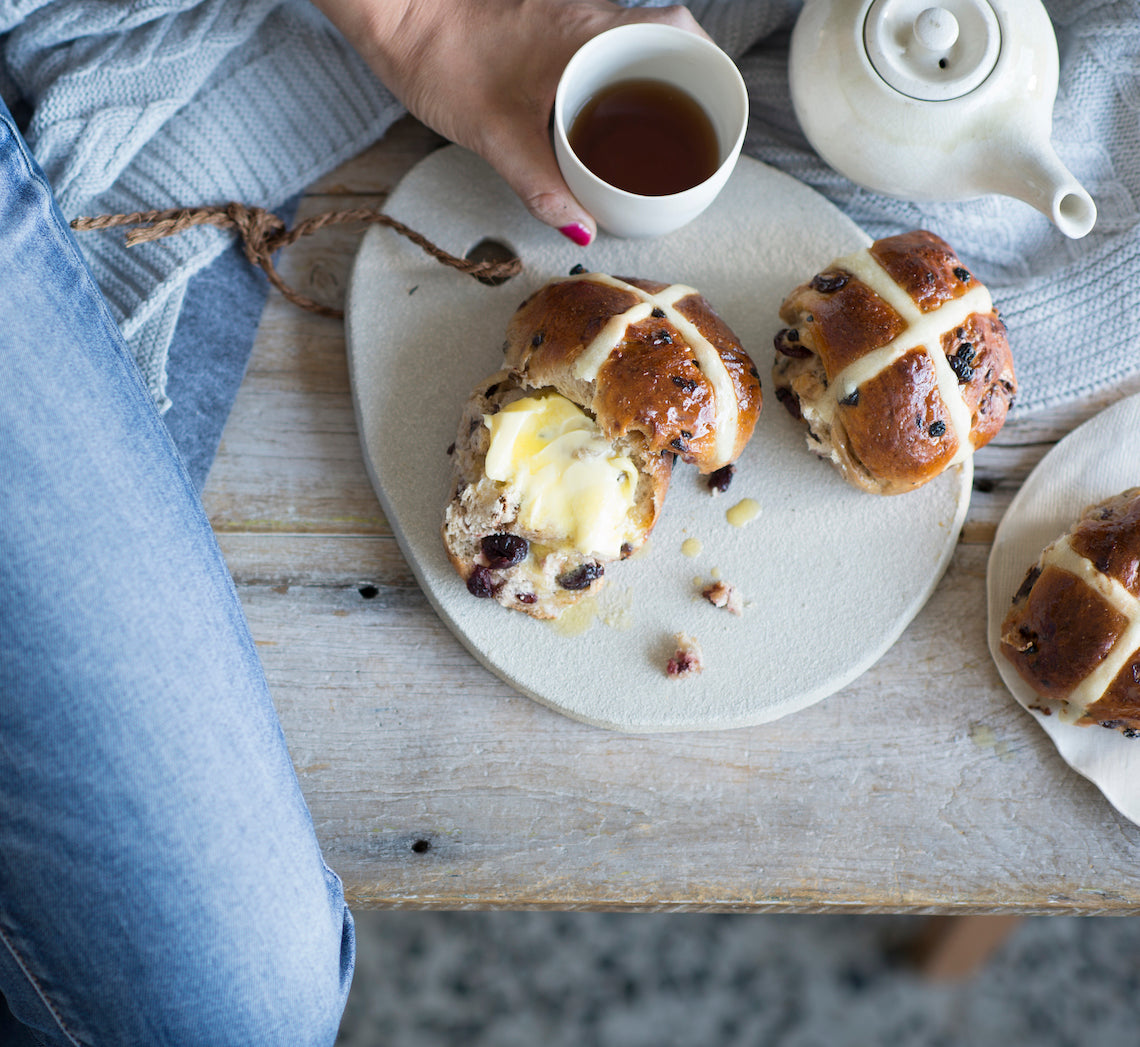
Prep 25min (+1hr 30min proving time)Bake 25minMakes 12
An updated version of the traditional favourite, these hot cross buns are studded with chunks of dark chocolate and tart, dried cherries. They're simply too hard to resist – especially when served warm with lashings of butter!
Ingredients
750g (5 cups/1lb 10½oz) strong bread or pizza (high protein) flour (see Baker's Tips)
55g (¼ cup/2oz) caster sugar
2 x 7g sachets (4 teaspoons) instant dried yeast
1½ teaspoons mixed spice
1½ teaspoons ground cinnamon
1 teaspoon salt
150g (1 cup/5¼oz) dried cherries (see Baker's Tips)
75g (½ cup/2¾oz) currants
435ml (1¾ cups/14¾fl oz) milk
60g (2fl oz) salted butter, cubed, plus extra, to grease and serve
2 eggs, at room temperature
1 teaspoon natural vanilla essence or extract
100g (3½oz) good-quality dark chocolate, chopped
Flour paste
75g (½ cup/2¾oz) plain flour
75ml (2½fl oz) water
Glaze
55g (¼ cup/ 2oz) caster sugar
2 tablespoons water
Method
- Put the bread flour, sugar, yeast, mixed spice, cinnamon and salt in a large bowl and mix to combine. Stir through the dried cherries and currants.
- Heat the milk and butter in a small saucepan over medium heat until the butter has just melted and the milk is lukewarm. Whisk one of the eggs with the vanilla and add to the milk mixture. Whisk to combine. Add to the dry ingredients and use a wooden spoon and then your hands to mix to a soft dough.
- Turn out onto a lightly floured bench top. Knead for 8-10 minutes or until smooth and elastic. Lightly grease a clean large bowl with a little butter, add the dough and turn to coat the dough. Cover with plastic wrap and set aside in a warm, draught-free place for 1 hour or until doubled in volumn.
- Line a large baking tray with baking paper. Punch the centre of the dough down with your fist. Turn onto a lightly floured bench top. Knead for 2-3 minutes or until smooth. Knead in the chocolate until evenly combined. Divide the dough into 12 equal portions. Roll each portion into a ball and place on the tray, allowing a little room for spreading. Cover with a damp tea towel and set aside in a warm, draught-free place for 30 minutes or until almost doubled in size.
- Preheat the oven to 180°C/350°F (160°C/315°F fan-forced). Meanwhile, make the Flour Paste. Combine the flour and water in a bowl and beat with a wooden spoon until smooth. Spoon into a small, good-quality snap-lock bag and seal.
- Whisk the remaining egg and brush the tops of the buns with it. Snip a small hole in the corner of the snap-lock bag containing the Flour Paste and pipe crosses on the buns.
- Bake in the preheated oven for 25 minutes or until the buns are cooked and sound hollow when tapped on the base.
- Meanwhile, make the Glaze. Combine the sugar and water in a small saucepan over medium heat and stir until the sugar dissolves. Bring to a simmer and simmer for 1 minute. Transfer the hot cross buns to a wire rack and brush the tops with the glaze. Serve warm, spread with butter.
Baker's Tips
- Bread and pizza flour (also known as 'strong' flour) has a higher gluten content than regular plain flour. This type of flour is more suited to use in yeast-based bread recipes like these buns and will give you a better final texture (the resulting bread will be more 'bread-like' with a slightly chewy texture rather than a fine, cake-like texture). Look for a protein content of around 11-13 percent for the best results with this recipe.
- Dried cherries are available at selected supermarkets, delicatessens, grocery shops and specialty food stores. You can replace them with good-quality dried cranberries.
- These hot cross buns are best eaten the day they are made although they will freeze well. To freeze, wrap in plastic wrap and then seal in an airtight container or freezer bag and freeze for up to 3 months. Thaw them at room temperature or split while still frozen and toast.
Recipe from BakeClass by Anneka Manning (Murdoch Books).
Photography by Alan Benson.
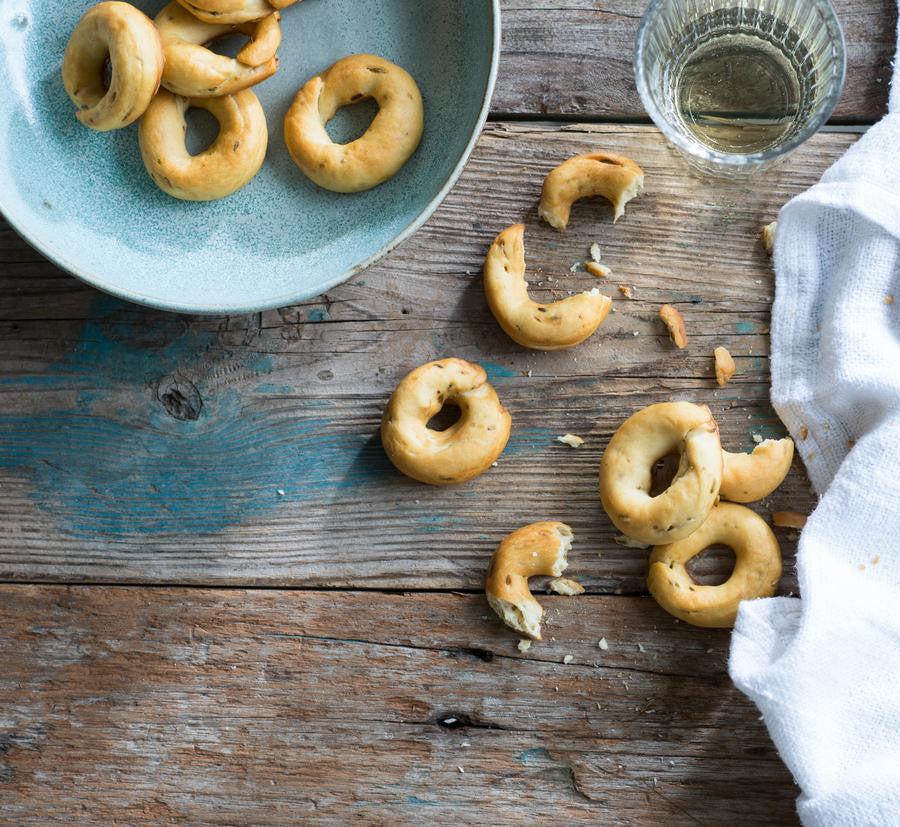
Prep 50min (+1hr 30min proving time)Bake 1hr 5minMakes about 36
Traditionally served as a stuzzichini (an appetiser snack), these cute, crisp, fennel-scented biscuits hail from the Puglia region in the heel of Italy’s boot. Traditionally associated with Easter you will also often find them served throughout the year alongside an aperitif for dunking.
Ingredients
80ml (⅓ cup) lukewarm water
1 teaspoon dried yeast
60ml (¼ cup) extra virgin olive oil
60ml (¼ cup) dry white wine
300g (2 cups) bread or pizza flour, plus extra to dust (see Baker's Tips)
1 tablespoon fennel seeds, coarsely crushed
1 teaspoon freshly ground black pepper
1 teaspoon salt
1 tablespoon bicarbonate of soda
Method
- Combine the water and yeast in a jug, stir to combine and set aside in a warm draught-free place for 5 minutes or until frothy.
- Add the olive oil and wine to the yeast mixture. Combine the flour, fennel seeds, pepper and salt in a large bowl, make a well in the centre and add the yeast mixture. Use a wooden spoon and then your hands to mix to a soft dough. Turn the dough onto a lightly floured surface and knead for 5-8 minutes or until it is smooth and elastic and springs back when you push your finger into it.
- Place the dough in an oiled bowl, turning it to coat lightly with the oil. Cover with plastic wrap and place in a warm, draught-free place for 1 hour or until almost doubled in size.
- Line two large oven trays with non-stick baking paper.
- Knock back the dough by punching it in the centre with your fist. Turn onto a lightly floured surface and knead for 1-2 minutes or until it returns to its original volume.
- Divide the dough into 12 even portions. Roll each portion into a rope about 30cm long and then cut each into three shorter lengths, each about 10 cm long. Roll each length until 15cm long. Join the ends of each length, pinching to seal, to form rings. Place on the lined oven trays, leaving a little room for rising between each, cover with plastic wrap or a slightly damp tea towel and set aside in a warm, draught-free place for about 30 minutes or until well puffed.
- Preheat oven to 180°C (160°C fan-forced). Fill a large saucepan or large deep frying pan with water until about 8cm deep. Add the bicarbonate of soda and bring to the boil.
- Reduce the heat so that the water is simmering. Working quickly, carefully add 6 of the rings to the boiling water. Once they rise to the surface (this will only take a few seconds) use a slotted spoon to transfer the rings, one at a time, back to the lined oven trays, allowing any excess water to drain away. Repeat with the remaining rings in 5 more batches.
- Bake in preheated oven for 25 minutes or until dark golden, swapping the trays after 12 minutes. Reduce the oven temperature to 110°C (90°C fan-forced) and continue to bake for a further 40 minutes, swapping the trays after 20 minutes, or until crisp all the way through. Cool on the trays.
Baker's Tips
- Bread and pizza flour (also known as ‘strong’ flour) has a higher gluten-content than regular plain flour. This type of flour is more suited to use in yeast-based bread recipes like these biscuits and will give you a better texture that will have more ‘bite’ rather than a fine cake-like crumbly texture.
- These biscuits will keep in an airtight container at room temperature for up to 2 weeks.
- The butter for this recipe needs to be soft enough to spread but not so soft that is starts melting when you spread it.
- This bread is best eaten on the day it is made but will keep in an airtight container for up to 2 days.
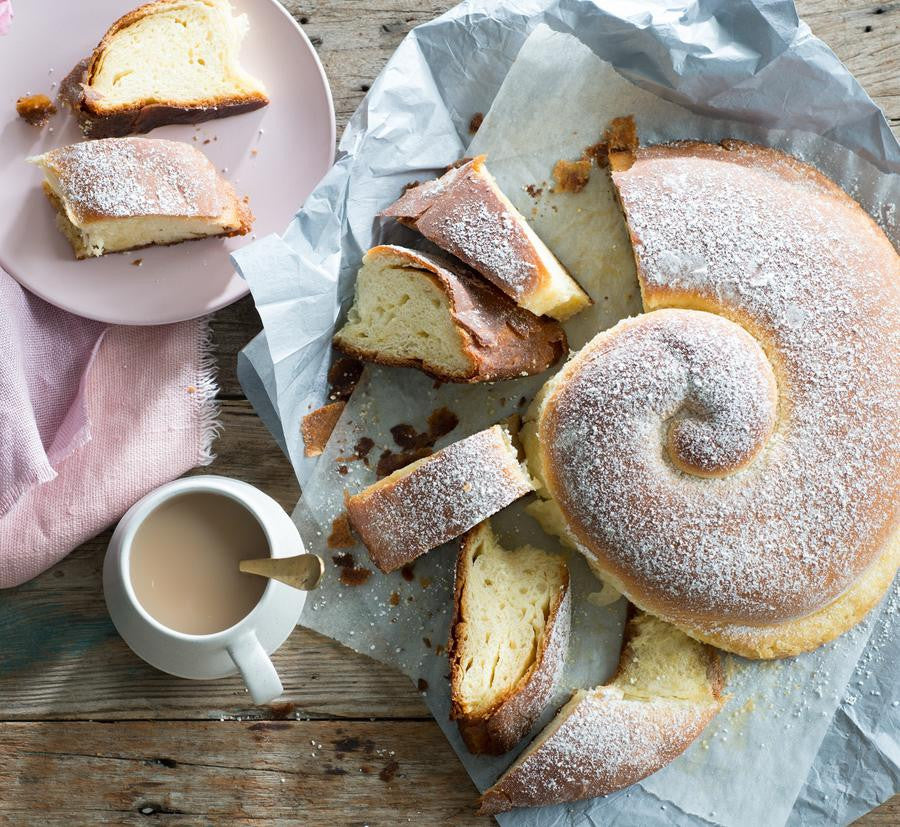
Prep 50min (+10min cooling, 15min chilling and 2hrs proving time)Bake 30minMakes 12 serves
This amazing Spanish bread is reminiscent of the croissant from neighbouring France – traditionally layered with lard (although I make mine with butter) this brioche-like bread has a wonderful flakiness and rich buttery flavour that is simply too hard to resist. Originally from the Isle of Mallorca it is traditionally served at festivals and celebrations such as Easter however, these days, it is often found on the breakfast table – trust me, it really is too good to keep for special occasions!
Ingredients
200ml (7fl oz) lukewarm milk
1 x 7g sachet (2 teaspoons) instant dried yeast
110g (½ cup/4oz) caster sugar
2 eggs, at room temperature
450g (3 cups/15¾oz) strong bread or pizza (high-protein) flour, plus extra to dust (see Baker's Tips)
¼ teaspoon fine salt
Melted butter, to grease
200g (7oz) salted butter, cubed, softened (see Baker’s Tips)
Icing sugar, to dust
Method
- Combine the milk, yeast and 1 teaspoon of the sugar in a jug. Stir to combine and set aside in a warm draught-free place for 5 minutes or until frothy. Add the eggs and use a fork to whisk to combine.
- Combine the flour, remaining sugar and salt in the bowl of a stand mixer. On low speed gradually add the milk mixture and knead with a dough hook. Continue to knead on low speed for 6-8 minutes or until the dough is smooth and elastic.
- Brush a medium bowl with melted butter to grease. Place the dough in the bowl, turning it to coat lightly with the butter. Cover with plastic wrap and place in a warm, draught-free place for 1 hour or until doubled in volume.
- Line a large oven tray with non-stick baking paper.
- When the dough has doubled in size knock it back by punching it in the centre with your fist. Turn onto a lightly floured surface and knead for 1-2 minutes or until it returns to its original volume.
- Use a lightly floured rolling pin to roll out the dough on a lightly floured surface to a 45cm/18in square. Working quickly, use a palette knife to carefully spread the butter all over the dough to cover evenly, leaving a 2cm/¾in border. Roll up the dough into a roll to enclose the butter and then press the ends to seal. With an end closest to you, gently roll out the dough again to a rectangle about 60cm/24in long and 15cm/6in wide, dusting the dough with a little flour if the butter breaks through. Starting from a long end, roll up the dough again to form a long roll.
- Loosely coil the roll onto the lined baking tray. Cover with a slightly damp tea towel and chill for 15 minutes. Remove form the fridge and set aside in a warm draught-free place for 1 hour or until well risen.
- Preheat oven to 180°C/350°F (160°C/315°F fan-forced).
- Bake the Ensaïmada in preheated oven for 30 minutes or until cooked through and golden. Place the baking tray on a wire rack and set aside on the tray for at least 10 minutes to cool slightly before serving warm or cool completely. Serve dusted liberally with icing sugar.
Baker's Tips
- The butter for this recipe needs to be soft enough to spread but not so soft that is starts melting when you spread it.
- This bread is best eaten on the day it is made but will keep in an airtight container for up to 2 days.
This recipe is from Anneka's SBS Food online column Bakeproof: Easter Treats. Click here for more Bakeproof columns and recipes.
Photography by Alan Benson.






